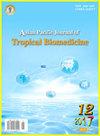紫丁香酸在Cu (II)离子存在下通过促氧化活性诱导癌细胞死亡
IF 1.7
4区 医学
Q3 TROPICAL MEDICINE
引用次数: 0
摘要
目的:研究丁香酸在不存在和存在外源Cu(II)和Fe(II)离子的情况下对HEK293和HepG2细胞的影响。方法:采用MTT法检测丁香酸在不存在和存在外源Cu(II)和Fe(II)离子的情况下对HEK293和HepG2细胞的抗增殖作用。此外,还研究了集落形成、活性氧(ROS)产生、细胞凋亡诱导、自噬、线粒体膜电位和线粒体质量。结果:在24和72小时,对照组和丁香酸+Fe(II)组的HepG2细胞的活力没有观察到显著差异。然而,HepG2细胞暴露于丁香酸+Cu(II)72小时显著降低了细胞活力。此外,HepG2细胞中ROS的形成、细胞凋亡的诱导和自噬液泡显著增加,线粒体膜电位和线粒体质量没有显著变化。此外,丁香酸+Cu(II)显著降低了铺板效率和存活率。结论:紫丁香酸与Cu(II)联合应用对癌症细胞有一定毒性,并具有抗氧化活性。此外,这种组合在癌症细胞中诱导自噬,对正常细胞的细胞毒性作用较小,这是开发癌症新疗法的潜在候选。本文章由计算机程序翻译,如有差异,请以英文原文为准。
Syringic acid induces cancer cell death in the presence of Cu (II) ions via pro-oxidant activity
Objective: To investigate the effects of syringic acid on HEK 293 and HepG2 cells in the absence and presence of exogenous Cu (II) and Fe (II) ions. Methods: The antiproliferative effects of syringic acid on HEK 293 and HepG2 cells in the absence and presence of exogenous Cu (II) and Fe (II) ions were examined by MTT assay. Additionally, colony-forming, reactive oxidative species (ROS) generation, apoptosis induction, autophagy, mitochondrial membrane potential, and mitochondrial mass were investigated. Results: At 24 and 72 h, no significant differences were observed in the viability of HepG2 cells between the control and syringic acid + Fe (II) groups. However, exposure of HepG2 cells to syringic acid + Cu (II) for 72 h reduced the cell viability significantly. Furthermore, ROS formation, induction of apoptosis, and autophagic vacuoles were significantly increased in HepG2 cells without marked changes in mitochondrial membrane potential and mitochondrial mass. Moreover, syringic acid + Cu (II) reduced the plating efficiency and surviving fraction significantly. Conclusions: The combination of syringic acid with Cu (II) was toxic to cancer cells and showed pro-oxidant activity. In addition, this combination induced autophagy in cancer cells with less cytotoxic effects on normal cells, which is a potential candidate for the development of novel therapeutics towards cancer.
求助全文
通过发布文献求助,成功后即可免费获取论文全文。
去求助
来源期刊

Asian Pacific journal of tropical biomedicine
Biochemistry, Genetics and Molecular Biology-Biochemistry, Genetics and Molecular Biology (miscellaneous)
CiteScore
3.10
自引率
11.80%
发文量
2056
审稿时长
4 weeks
期刊介绍:
The journal will cover technical and clinical studies related to health, ethical and social issues in field of biology, bacteriology, biochemistry, biotechnology, cell biology, environmental biology, microbiology, medical microbiology, pharmacology, physiology, pathology, immunology, virology, toxicology, epidemiology, vaccinology, hematology, histopathology, cytology, genetics and tropical agriculture. Articles with clinical interest and implications will be given preference.
 求助内容:
求助内容: 应助结果提醒方式:
应助结果提醒方式:


